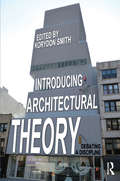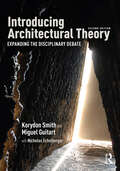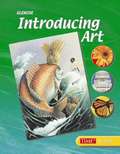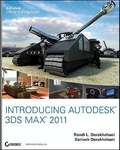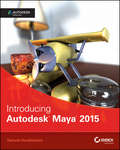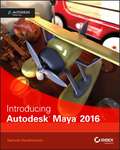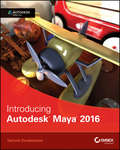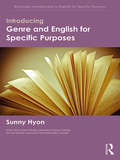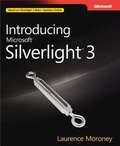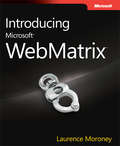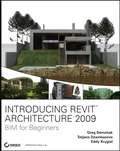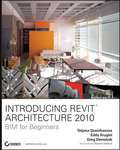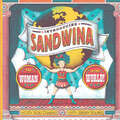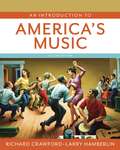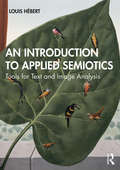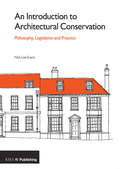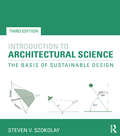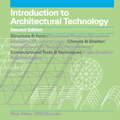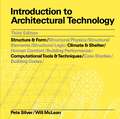- Table View
- List View
Introducing Architectural Theory: Debating a Discipline
by Korydon SmithThis is the most accessible architectural theory book that exists. Korydon Smith presents each common architectural subject – such as tectonics, use, and site – as though it were a conversation across history between theorists by providing you with the original text, a reflective text, and a philosophical text. He also introduces each chapter by highlighting key ideas and asking you a set of reflective questions so that you can hone your own theory, which is essential to both your success in the studio and your adaptability in the profession. These primary source texts, which are central to your understanding of the discipline, were written by such architects as Le Corbusier, Robert Venturi, and Adrian Forty. The appendices also have guides to aid your reading comprehension; to help you write descriptively, analytically, and disputationally; and to show you citation styles and how to do library-based research. More than any other architectural theory book about the great thinkers, Introducing Architectural Theory teaches you to think as well.
Introducing Architectural Theory: Expanding the Disciplinary Debate
by Korydon Smith Miguel GuitartBuilding on the success of the first edition, an engaging and reader-friendly work on complex ideas, Introducing Architectural Theory: Expanding the Disciplinary Debate, broadens the range of themes, voices, and geographies represented to provide a more comprehensive and contemporary theory book. This book presents major discourses in architectural theory and design in a debate-like format, integrating a series of edited texts across architectural history with context and newly written commentaries by the authors. This new edition has been fully revised, updated, and expanded to include long-standing debates, such as simplicity vs. complexity or the relationship between form and function, as well as newer discussions on innovation, globalization, and social equity. Authors Smith and Guitart provide a comprehensive means and conceptual framework for readers to compare multiple points of view. The chapter structure, discussion questions, and additional resources allow teachers to facilitate in-class discussions and writing assignments. This book remains the most accessible architectural theory textbook, written for beginning architecture students and those outside the discipline. Its reflective and critical approach will equally engage the minds of upper-level students and experts.
Introducing Art
by Gene Mittler Jean Morman Unsworth Rosalind Ragans Faye ScannellThe book presents, with a thematic focus, a wide range of artworks and styles and groups them by the themes that served as inspiration for the works--people, places, animals and nature. Animals and stick people appeared on the walls of caves more than twelve thousand years ago which today as a visual link to our forebears. Celebrations and events are commemorated in paintings, sculpture, and photographs. These and other themes in Introducing Art will bring creative inspiration to the classroom.
Introducing Autodesk 3ds Max 2011
by Dariush DerakhshaniAn Autodesk Official Training Guide to 3ds Max 2011 3ds Max is a popular 3D animation-and-effects software used in movies, visual effects, games, cartoons, short films, commercials, and other animation. However, it also presents a number of challenges to newcomers. This introduction to the latest version breaks down the complexities of learning 3D software and walks you through the basics of modeling, texturing, animating, and using visual effects. Real-world examples from talented beginning 3ds max users motivate you to learn the software and helpful tutorials offer realistic, professional challenges for you to unravel. In addition, each chapter is richly illustrated with workflows to make learning 3ds max 2011 much easier and fn. Introduces you to the basics of modeling, texturing, animating, and incorporating visual effects using the latest version of 3ds Max software Features excellent tutorials, helpful examples, detailed workflows, and a companion Web site to enhance your learning experience Explains a variety of methods for solving real-world challenges and breaks down why certain methods are used Makes the transition of coming from other 3D software applications as smooth as possible Introducing 3ds Max 2011 takes a typically difficult subject and breaks into easily digestible pieces so you can confidently begin working with this 3D animation software today.
Introducing Autodesk Maya 2015
by Dariush DerakhshaniLearn Autodesk Maya from an award-winning insider <P><P> Best-selling author, visual effects supervisor, and technical educator Dariush Derakhshani brings you a newly-updated, step-by-step guide to the most popular and complex 3D application on the market, Autodesk Maya. Introducing Autodesk Maya 2015 includes straightforward lessons, real-world examples, detailed tutorials, and downloadable project files that get you modeling and animating your own digital models and scenes right away.<P> The book starts you with the latest CG concepts and production workflows, and then shows you how to create a solar system to help get you acquainted with the basic tool set in Maya. From there, the books helps you: <P> * Learn the Maya user interface, including menus and plug-ins <P> * Build simple animations and 3D images right away <P> * Explore polygons, modeling, and NEX tools<P> * Get started with HDRI lighting, rendering, dynamics, simulations, and effects <P> Whether you're new to 3D or migrating from another 3D application, Introducing Autodesk Maya 2015 will kick-start your creativity and get you up and running with Maya. Author Derakhshani has worked on movies such as The Fantastic Four and Pan's Labyrinth, the South Park TV series, and numerous commercials and music videos.
Introducing Autodesk Maya 2016: Autodesk Official Press
by Dariush DerakhshaniStart modeling right away with this hands-on guide to learning Autodesk Maya 2016 Introducing Autodesk Maya 2016 is the official guide to the most popular and complex 3D application on the market. Building from the ground up, this book combines straightforward text with practical examples that make it easy to absorb the basics and start designing and animating your own digital models and scenes. The tutorials offer realistic challenges and clear explanations, laid out in fun, step-by-step lessons that help you gain confidence and learn by doing. You'll delve into CG and 3D core concepts and production workflows, then get right to work designing an animation of the solar system as you learn the interface and basic tools. As your modeling skills grow, you'll build a steam locomotive, a starfish, a table lamp, and much more as you learn to rig your model for animation, create fabric motion with nCloth, and add the lighting and effects that bring your scenes to life. The companion website features downloadable project files that help you see how the pros do it, and the book includes real-world examples from talented users who were beginners just like you. Master the Maya 2016 interface, menus, and plug-ins Begin building simple animations right away Explore modeling, rendering, animation, and cloth motion Add lighting, rendering, dynamics, simulations, and effects If you want to work like the pros, Introducing Autodesk Maya 2016 is the perfect primer for getting started.
Introducing Autodesk Maya 2016: Autodesk Official Press
by Dariush DerakhshaniStart modeling right away with this hands-on guide to learning Autodesk Maya 2016 Introducing Autodesk Maya 2016 is the official guide to the most popular and complex 3D application on the market. Building from the ground up, this book combines straightforward text with practical examples that make it easy to absorb the basics and start designing and animating your own digital models and scenes. The tutorials offer realistic challenges and clear explanations, laid out in fun, step-by-step lessons that help you gain confidence and learn by doing. You'll delve into CG and 3D core concepts and production workflows, then get right to work designing an animation of the solar system as you learn the interface and basic tools. As your modeling skills grow, you'll build a steam locomotive, a starfish, a table lamp, and much more as you learn to rig your model for animation, create fabric motion with nCloth, and add the lighting and effects that bring your scenes to life. The companion website features downloadable project files that help you see how the pros do it, and the book includes real-world examples from talented users who were beginners just like you. Master the Maya 2016 interface, menus, and plug-ins Begin building simple animations right away Explore modeling, rendering, animation, and cloth motion Add lighting, rendering, dynamics, simulations, and effects If you want to work like the pros, Introducing Autodesk Maya 2016 is the perfect primer for getting started.
Introducing Genre and English for Specific Purposes (Routledge Introductions to English for Specific Purposes)
by Sunny HyonGenre analysis has become a key approach within the field of English for Specific Purposes and helps students understand particular language use patterns in target contexts. Introducing Genre and English for Specific Purposes provides an overview of how genre has been conceptualized and applied in ESP, as well as the features that distinguish ESP genre research and teaching from those of other genre schools. The macro and micro aspects of ESP genre-based pedagogy are also analysed and include: different possibilities for planning and designing an ESP genre-based course; the concrete, micro aspects of materials creation; and how genres can be learned through play. Introducing Genre and English for Specific Purposes is essential reading for students and pre-service teachers who are studying Genre, English for Specific Purposes or language teaching methodologies.
Introducing Microsoft® Silverlight™ 3
by Laurence MoroneyGet a running start with Silverlight 3--the cross-platform, cross-browser plug-in for rich interactive applications and cutting-edge media experiences. Featuring advance insights from inside the Microsoft Silverlight team--this book provides practical, grounded advice, rich examples, and ready code to help inspire your next solutions. Discover how to: Create your first simple sites Build applications that run out of the browser Use XAML to render, scale, and animate graphics on-screen Work with Silverlight Tools for Visual Studio Explore core and advanced controls--and build your own Exploit new graphics support--3-D effects, H.264 video, GPU acceleration Experiment with media, ink, DeepZoom, and Photosynth * Access data services to build connected applications Dynamically add content using Ruby and Python Manage Silverlight applications from ASP.NET-based servers Learn how to deliver DRM-protected video content
Introducing Microsoft® WebMatrix™
by Laurence MoroneyYour first look at the easy-to-use tools for building your own data-driven website Get a running start with Microsoft WebMatrix--the free, downloadable web development solution featuring all the tools you need for server-side programming. This practical book introduces the templates, helper libraries, and other tools in WebMatrix for building and customizing a data-driven site--including techniques for adding video, email, web forms, and other features. Learn how easy it can be to create a dynamic web presence for your small business or organization with WebMatrix. Get early, expert insights to help you: Write server-side code with either Microsoft ASP.NET or PHP Build a database application that lets you create, retrieve, update, and delete records Deliver video on your site with Microsoft Silverlight® or HTML5 Add simple email functions--or build your own email application Accept payments on your site with PayPal Capture user input by building web forms and controls Set up an application to promote your site through social networking Create a site with WordPress, and discover how to use other PHP-based web applications Get code samples on the web. For system requirements, see the Introduction.
Introducing Peace Museums (Routledge Research in Museum Studies)
by Joyce ApselNominated for the 2017 Dayton Literary Peace Prize in non-fiction This volume examines peace museums, a small and important (but often overlooked) series of museums whose numbers have multiplied world-wide in recent decades. They relate stories and display artifacts—banners, diaries, and posters for example about such themes as: art and peace, antiwar histories, protest, peacekeeping and social justice and promote cultures of peace. This book introduces their different approaches from Japan, which has the largest number of sites, to Bradford, UK and Guernica, Spain. Some peace museums and centers emphasize popular peace symbols and figures, others provide alternative narratives about conscientious objection or civil disobedience, and still others are sites of persuasion, challenging the status quo about issues of war, peace, disarmament, and related issues. Introducing Peace Museums distinguishes between different types of museums that are linked to peace in name, theme or purpose and discusses the debates which surround peace museums versus museums for peace. This book is the first of its kind to critically evaluate the exhibits and activities of this group of museums, and to consider the need for a "critical peace museum studies" which analyses their varied emphasis and content. The work of an experienced specialist, this welcome introduction to peace museums considers the challenges and opportunities faced by these institutions now and in the future.
Introducing Peace Museums (Routledge Research in Museum Studies)
by Joyce ApselNominated for the 2017 Dayton Literary Peace Prize in non-fiction This volume examines peace museums, a small and important (but often overlooked) series of museums whose numbers have multiplied world-wide in recent decades. They relate stories and display artifacts—banners, diaries, and posters for example about such themes as: art and peace, antiwar histories, protest, peacekeeping and social justice and promote cultures of peace. This book introduces their different approaches from Japan, which has the largest number of sites, to Bradford, UK and Guernica, Spain. Some peace museums and centers emphasize popular peace symbols and figures, others provide alternative narratives about conscientious objection or civil disobedience, and still others are sites of persuasion, challenging the status quo about issues of war, peace, disarmament, and related issues.Introducing Peace Museums distinguishes between different types of museums that are linked to peace in name, theme or purpose and discusses the debates which surround peace museums versus museums for peace. This book is the first of its kind to critically evaluate the exhibits and activities of this group of museums, and to consider the need for a "critical peace museum studies" which analyses their varied emphasis and content. The work of an experienced specialist, this welcome introduction to peace museums considers the challenges and opportunities faced by these institutions now and in the future.
Introducing Revit Architecture 2009
by Greg Demchak Eddy Krygiel Tatjana DzambazovaYou don't have to be a high-tech wizard to understand the Revit software using Introducing Revit Architecture 2009: BIM for Beginners, the perfect guide for architects of any generation. Start with an overview of BIM concepts before tackling the Revit interface, then move on to use Revit's suite of editing tools. Learn how to use Revit with other applications, document the model for construction, integrate annotations into the model, utilize worksets, and collaborate in a team environment from straightforward explanations, real-world examples, and practical tutorials.For Instructors: Teaching supplements are available for this title.
Introducing Revit Architecture 2009
by Eddy Krygiel Tatjana Dzambazova Greg DemchakYou don't have to be a high-tech wizard to understand the Revit software using Introducing Revit Architecture 2009: BIM for Beginners, the perfect guide for architects of any generation. Start with an overview of BIM concepts before tackling the Revit interface, then move on to use Revit's suite of editing tools. Learn how to use Revit with other applications, document the model for construction, integrate annotations into the model, utilize worksets, and collaborate in a team environment from straightforward explanations, real-world examples, and practical tutorials.For Instructors: Teaching supplements are available for this title.
Introducing Sandwina: The Strongest Woman in the World!
by Vicki ConradNo one believed a woman could be stronger than a man, until Katie Brumbach–also known as Sandwina—displayed her show-stopping feats as a circus strongwoman.100 pounds . . . 200 pounds . . . 300 pounds! Katie Brumbach became the world&’s top strongwoman after she ousted Eugen Sandow by lifting hundreds of pounds over her head (which Sandow could barely lift to his shoulders). After that, she took the last name Sandwina and thrived in the circus world—which she had been participating in since the age of two when she first performed with her family. She grew over six feet tall as she got older, but Katie never second-guessed herself, and she trained to build her muscles, always eager to test her skills and try new feats. After starting a family with a fellow performer, they were eventually signed to work with John Ringling of the Ringling Bros. Circus. Sandwina impressed the crowds by balancing a 1,000-pound cannon on her chest, by throwing a one-ton stone, and by having an iron slab broken on her body—she stole the show!
An Introduction to America's Music
by Richard Crawford Larry HamberlinRichard Crawford and Larry Hamberlin show how the lively interactions between the folk, popular, and classical spheres have made American music resonate with audiences around the world. Students will learn how to listen critically to eighty-eight pieces in all the major styles and genres, while gaining a clearer understanding of music's role in the history of American society, business, and technology.
An Introduction to Applied Semiotics: Tools for Text and Image Analysis
by Louis HébertAn Introduction to Applied Semiotics presents nineteen semiotics tools for text and image analysis. Covering a variety of different schools and approaches, together with the author’s own original approach, this is a full and synthetic introduction to semiotics. This book presents general tools that can be used with any semiotic product. Drawing on the work of Fontanille, Genette, Greimas, Hébert, Jakobson, Peirce, Rastier and Zilberberg, the tools deal with the analysis of themes and action, true and false, positive and negative, rhythm narration and other elements. The application of each tool is illustrated with analyses of a wide range of texts and images, from well-known or distinctive literary texts, philosophical or religious texts or images, paintings, advertising and everyday signs and symbols. Each chapter has the same structure – summary, theory and application – and includes exercises and discussion questions, making it ideal for course use. Covering both visual and textual objects, this is a key text for all courses in semiotics and textual analysis within linguistics, communication studies, literary theory, design, marketing and related areas.
An Introduction to Architectural Conservation: Philosophy, Legislation and Practice
by Nick Lee EvansThere are over half a million listed buildings in Britain, conservation areas can be found in every borough, and a large proportion of our housing stock pre-dates 1914. So, whether in extending a listed house, reordering a local church, or converting an historic warehouse, most architects will work with historic buildings at some point in their career – even if they are not a specialist conservation architect.An Introduction to Architectural Conservation introduces non-specialist architects to the principles behind legislation concerning historic buildings. It will help them understand the practicalities of this legislation, the aims and objectives of Conservation Offices, Statutory Amenity Societies and other guardians of our heritage. With these skills, readers can advise clients more accurately, make successful listed building applications, and ensure their interventions are sensitive, appropriate and effective. An Introduction to Architectural Conservation is also a practical guide to good working practice: taking readers through the process of preparing a listed building application, preparing a suitable tender package and administering the contract..
Introduction to Architectural Science: The Basis of Sustainable Design
by Steven V. SzokolayNow in its third edition, this book provides the ideal and only reference to the physical basis of architectural design. Fully updated and expanded throughout, the book provides the data required for architects to design buildings that will maintain the users comfort in a variety of conditions, with minimal reliance on energy intensive methods like air conditioning. This is not a ‘how to’ book but answers the question why. It equips the reader with the tools to realize the full potential of the good intentions of sustainable, bioclimatic design. All sections have been revised and updated for this third edition including all the most relevant developments affecting heat, light and sound controls. The book responds to the need of understanding beyond ‘rules of thumb’.
Introduction to Architectural Technology 2e
by William McLeanUnderstanding the relationship between design and technology is critical to the understanding of architecture. This book clearly explains the core aspects of architectural technology: structural physics, structural elements and forms, heating, lighting, environmental control and computer modelling. Hundreds of photographs, diagrams and screengrabs demonstrate common architectural forms and construction techniques.Historical and contemporary examples chart significant moments in architectural engineering and the development of materials scienceIncludes an examination of computer-aided design (CAD) and the use of building information management (BIM) technology for predicting and analyzing the behaviour of buildings.Written by two experienced teachers, this essential introduction to architecture will help students to integrate their design thinking with the appropriate structural and environmental solutions.
Introduction to Architectural Technology 2e
by William McLeanUnderstanding the relationship between design and technology is critical to the understanding of architecture. This book clearly explains the core aspects of architectural technology: structural physics, structural elements and forms, heating, lighting, environmental control, and computer modelling.Hundreds of photographs, diagrams, and screengrabs demonstrate common architectural forms and construction techniques.Historical and contemporary examples chart significant moments in architectural engineering and the development of materials scienceIncludes an examination of computer-aided design (CAD) and the use of building information management (BIM) technology for predicting and analyzing the behavior of buildings.Written by three experienced teachers, this essential introduction to architecture will help students to integrate their design thinking with the appropriate structural and environmental solutions.
Introduction to Architectural Technology Second Edition
by Pete Silver Peter Silver William McLeanUnderstanding the relationship between design and technology is critical to the understanding of architecture. This book clearly explains the core aspects of architectural technology: structural physics, structural elements and forms, heating, lighting, environmental control, and computer modelling.Hundreds of photographs, diagrams, and screengrabs demonstrate common architectural forms and construction techniques.Historical and contemporary examples chart significant moments in architectural engineering and the development of materials scienceIncludes an examination of computer-aided design (CAD) and the use of building information management (BIM) technology for predicting and analyzing the behavior of buildings.Written by three experienced teachers, this essential introduction to architecture will help students to integrate their design thinking with the appropriate structural and environmental solutions.
Introduction to Architectural Technology Second Edition
by Pete Silver Peter Silver William McLeanUnderstanding the relationship between design and technology is critical to the understanding of architecture. This book clearly explains the core aspects of architectural technology: structural physics, structural elements and forms, heating, lighting, environmental control and computer modelling. Hundreds of photographs, diagrams and screengrabs demonstrate common architectural forms and construction techniques.Historical and contemporary examples chart significant moments in architectural engineering and the development of materials scienceIncludes an examination of computer-aided design (CAD) and the use of building information management (BIM) technology for predicting and analyzing the behaviour of buildings.Written by two experienced teachers, this essential introduction to architecture will help students to integrate their design thinking with the appropriate structural and environmental solutions.
Introduction to Architectural Technology Third Edition
by Pete Silver William McLeanUnderstanding the relationship between design and technology is critical to the understanding of architecture. This book clearly explains the core aspects of architectural technology: structural physics, structural elements and forms, heating, lighting, environmental control and computer modelling. The third edition includes six new case studies, more on structural types, new information on construction detailing, passive building principles and designing for different climatic conditions. This essential introduction to architecture will help students to integrate their design thinking with the appropriate structural and environmental solutions.
Introduction to Architectural Technology Third Edition
by Pete Silver William McLeanUnderstanding the relationship between design and technology is critical to the understanding of architecture. This book clearly explains the core aspects of architectural technology: structural physics, structural elements and forms, heating, lighting, environmental control and computer modelling. The third edition includes six new case studies, more on structural types, new information on construction detailing, passive building principles and designing for different climatic conditions. This essential introduction to architecture will help students to integrate their design thinking with the appropriate structural and environmental solutions.
